When we think of nature’s most magnificent predators, eagles soar to the top of our minds with their piercing gaze and powerful wingspan. These apex birds have captivated humans for centuries, symbolizing freedom, strength, and raw wilderness in cultures worldwide.
We’ve all witnessed their breathtaking hunting displays on nature documentaries, but there’s so much more to discover about these remarkable raptors. From their incredible eyesight that’s four times sharper than ours to their impressive speeds reaching over 100 mph during dives, eagles possess extraordinary adaptations that make them master hunters of the sky.
Whether you’re a bird enthusiast or simply curious about wildlife, we’ll explore the intriguing area of eagles and uncover the secrets behind their legendary status. You’ll discover why these majestic creatures continue to inspire awe and respect across every continent they call home.
What Makes the Eagle Bird So Special
Eagle birds possess extraordinary physiological adaptations that set them apart from other raptors. Their vision reaches 4 to 8 times sharper than human eyesight, allowing them to spot prey from distances exceeding 2 miles away. Large eyes occupy nearly 50% of their skull space, containing specialized cells called fovea that process visual information with remarkable precision.
Physical Characteristics That Define Eagle Excellence
| Feature | Measurement | Function |
|---|---|---|
| Wingspan | 6-8 feet (varies by species) | Enhanced lift and soaring efficiency |
| Diving Speed | Up to 200 mph | High-speed prey capture |
| Talon Grip Force | 750 psi | Secure prey restraint |
| Flight Altitude | Up to 20,000 feet | Thermal exploitation and territory coverage |
Powerful talons serve as their primary hunting weapons, generating crushing forces that instantly incapacitate prey animals like fish, small mammals, and birds. These razor-sharp claws lock automatically when eagles grasp objects, creating an inescapable grip that requires conscious muscle relaxation to release.
Hunting Strategies and Behavioral Excellence
Eagles demonstrate sophisticated hunting techniques that showcase their intelligence and adaptability. Bald eagles often engage in cooperative fishing, where multiple individuals work together to drive schools of fish toward shallow waters. Golden eagles employ calculated stooping attacks, diving from great heights to strike prey with devastating accuracy and force.
Territorial behavior reinforces their dominance within ecosystems, with breeding pairs defending areas spanning 1 to 6 square miles depending on food availability and habitat quality. Their nests, called eyries, can weigh over 2 tons after years of continuous construction and represent some of the largest bird structures in North America.
Cultural Significance Across Civilizations
Throughout human history, eagle symbolism has represented power, freedom, and divine connection across diverse cultures. Ancient Romans adopted eagles as military standards, while Native American tribes consider them sacred messengers between earthly and spiritual realms. Modern nations continue this tradition, with over 25 countries featuring eagles on their national emblems and currency.
These remarkable adaptations and cultural importance combine to create the eagle’s legendary status as nature’s apex aerial predator and humanity’s enduring symbol of strength.
Physical Characteristics of Eagle Birds
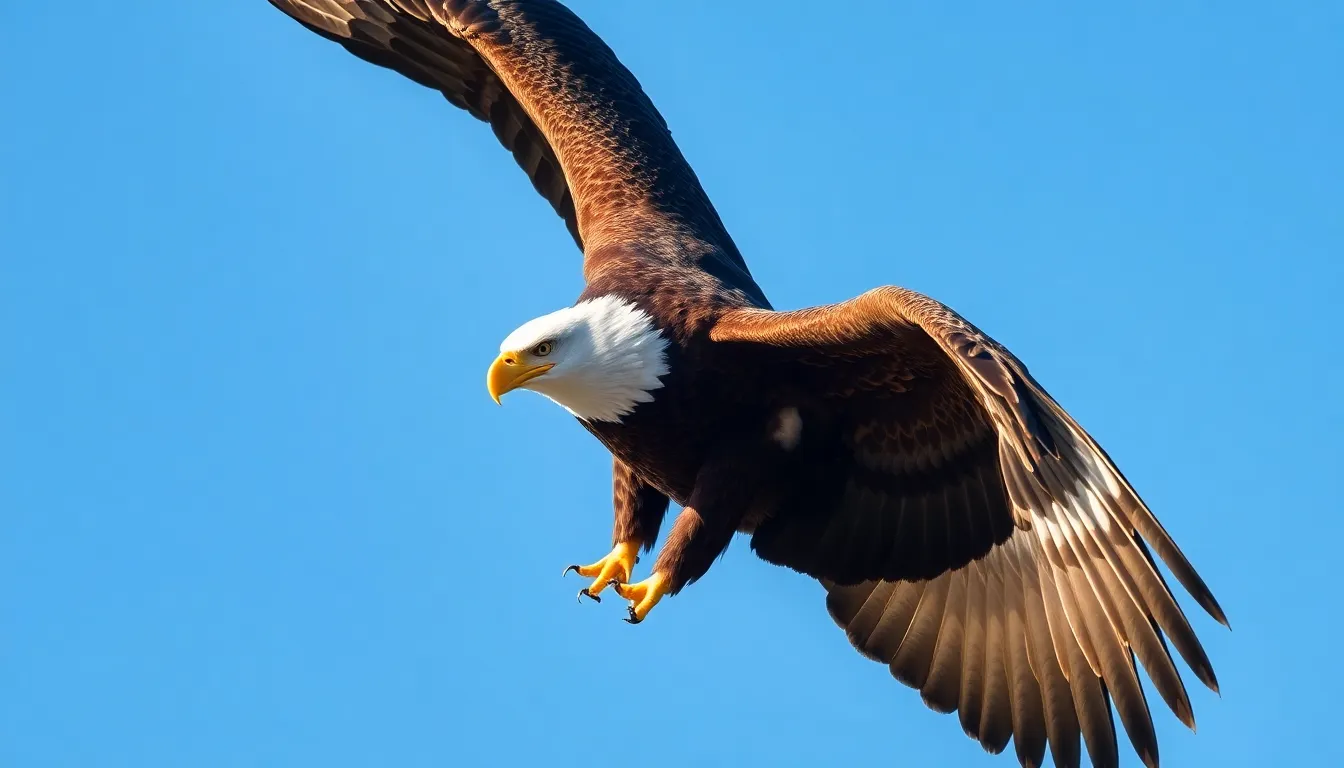
Eagles possess distinctive physical attributes that make them apex predators in the avian industry. Their remarkable anatomical features work together to create one of nature’s most efficient hunting machines.
Size and Wingspan
Eagle birds demonstrate impressive size variations across different species, with body lengths ranging from 24 to 40 inches. Golden eagles typically measure 28 to 33 inches in length while weighing between 6 to 15 pounds. Bald eagles showcase even more substantial proportions with weights reaching up to 14 pounds for females.
Wingspan measurements reveal the true majesty of these birds, stretching between 6 to 8 feet across most species. Steller’s sea eagles hold the record for the largest wingspan among eagle species at up to 8.5 feet. This expansive wing surface provides exceptional lift and allows eagles to soar effortlessly on thermal currents for hours without flapping.
| Eagle Species | Average Length | Weight Range | Wingspan |
|---|---|---|---|
| Bald Eagle | 28-40 inches | 6.5-14 lbs | 6-7.5 feet |
| Golden Eagle | 28-33 inches | 6-15 lbs | 6-7.5 feet |
| Steller’s Sea Eagle | 33-41 inches | 11-20 lbs | 7-8.5 feet |
Sharp Talons and Powerful Beak
Talons serve as the primary weapons in an eagle’s hunting arsenal, featuring razor-sharp curves that can pierce through prey with devastating precision. These formidable claws generate a grip force of 750 pounds per square inch, allowing eagles to snatch fish from water surfaces or small mammals from the ground. Each foot contains four toes equipped with talons that can grow up to 3 inches in length on larger species.
Eagle beaks complement their powerful talons with equally impressive design features optimized for tearing flesh. The hooked upper mandible creates a perfect tool for ripping apart prey once captured. Beak strength varies by species, with larger eagles like the harpy eagle possessing beaks capable of crushing bones up to 2 inches thick.
Exceptional Eyesight
Vision capabilities in eagles surpass human eyesight by 4 to 8 times, making them among the most visually acute animals on Earth. Their eyes occupy approximately 50% of their skull space, containing specialized cells called photoreceptors that detect the slightest movements from distances exceeding 2 miles. Eagles can spot a rabbit moving in grass from over 3 miles away under optimal conditions.
Eye structure includes a higher density of cone cells compared to human eyes, providing enhanced color discrimination and detail recognition. Each eagle eye contains roughly 1 million nerve fibers connecting to the brain, compared to just 200,000 in human eyes. This superior wiring allows for instantaneous processing of visual information during high-speed dives and complex hunting maneuvers.
Different Species of Eagle Birds
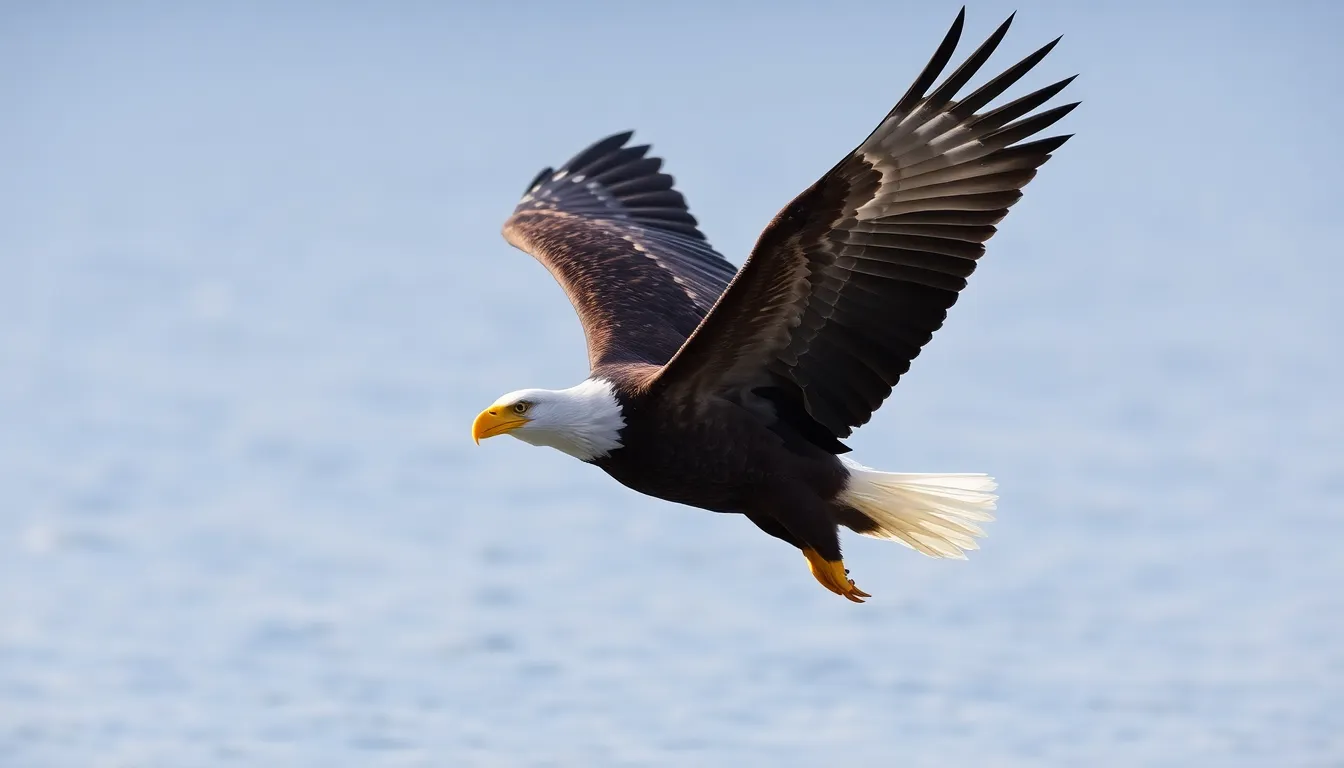
Eagles cover over 60 distinct species worldwide, each displaying unique characteristics and remarkable hunting abilities. We examine three of the most notable species that demonstrate the incredible diversity within the eagle family.
Bald Eagle
Haliaeetus leucocephalus represents America’s national bird and showcases one of conservation’s greatest success stories. Adult bald eagles develop their distinctive white head feathers at 5 years of age, while juveniles display mottled brown plumage throughout their bodies.
These magnificent raptors measure 28 to 40 inches in length with wingspans reaching 7.5 feet. Bald eagles primarily hunt fish, diving from heights of 100 feet to snatch salmon and trout from water surfaces. Their populations recovered from just 417 breeding pairs in 1963 to over 71,400 pairs by 2019 following DDT bans and intensive conservation efforts.
Nesting behaviors include constructing massive eyries weighing up to 4,409 pounds in tall trees near water sources. Breeding pairs return to the same territories annually, adding new materials to their existing structures each season.
Golden Eagle
Aquila chrysaetos dominates mountainous regions across North America, Europe, and Asia with exceptional soaring capabilities. Golden eagles possess dark brown plumage with distinctive golden head feathers that give this species its common name.
Hunting strategies focus on medium-sized mammals including rabbits, marmots, and young deer. These eagles reach diving speeds exceeding 150 mph during hunting strikes, using their powerful talons to deliver fatal grips. Territory sizes span 20 to 200 square miles depending on prey availability and habitat quality.
Physical measurements include body lengths of 26 to 40 inches and wingspans stretching 6 to 7.5 feet. Golden eagles demonstrate remarkable longevity, living up to 30 years in wild environments while maintaining their hunting prowess throughout their lifespans.
Harpy Eagle
Harpia harpyja rules the Amazon rainforest canopy as South America’s most powerful raptor species. Distinctive facial disc feathers create an owl-like appearance while improving their ability to detect sounds from prey moving through dense vegetation.
Talons measure up to 5 inches in length, making them larger than grizzly bear claws and capable of crushing bones. Harpy eagles specialize in hunting arboreal mammals including sloths, monkeys, and iguanas within the forest canopy layers.
Wing adaptations favor maneuverability over speed, with shorter wingspans of 6.5 feet allowing precise navigation through thick forest branches. Adult females weigh up to 20 pounds, making them nearly twice the size of males and among the heaviest eagles globally. Breeding cycles extend over 2 to 3 years, with pairs raising only one chick during each reproductive period.
Eagle Bird Habitat and Distribution

Eagle bird habitat spans across every continent except Antarctica and Australia, with these magnificent raptors adapting to diverse ecosystems from tropical rainforests to arctic tundra. Mountains provide ideal nesting locations for species like the Golden Eagle, which establishes territories covering 20 to 60 square miles in elevated regions across North America, Europe, and Asia. Coastal areas attract Bald Eagles, with over 70% of North American populations concentrated along waterways where fish populations remain abundant year-round.
Forest canopies serve as primary hunting grounds for Harpy Eagles throughout Central and South America, where they navigate dense vegetation to capture sloths, monkeys, and other arboreal mammals. Desert regions support Tawny Eagles across Africa and Asia, with these adaptable hunters covering territories exceeding 100 square miles while following seasonal prey migrations. Wetland ecosystems host White-bellied Sea Eagles along coastlines from India to Australia, where they patrol vast territories spanning up to 30 square kilometers.
| Eagle Species | Primary Habitat | Geographic Distribution | Territory Size |
|---|---|---|---|
| Bald Eagle | Coastal waters, large lakes | North America | 1-15 square miles |
| Golden Eagle | Mountains, open grasslands | North America, Europe, Asia | 20-60 square miles |
| Harpy Eagle | Tropical rainforests | Central and South America | 25-100 square kilometers |
| Steller’s Sea Eagle | Rocky coastlines | Eastern Russia, Japan | 10-50 square kilometers |
| Philippine Eagle | Primary forests | Philippine Islands | 25-100 square kilometers |
Climate variations influence eagle bird distribution patterns significantly, with northern species like the White-tailed Eagle occupying regions from Greenland to Japan where temperatures range from -40°F to 80°F annually. Tropical species demonstrate limited temperature tolerance, requiring consistent warmth between 70°F and 90°F throughout their ranges. Migration routes connect breeding and wintering grounds for many species, with Bald Eagles traveling distances exceeding 1,500 miles between seasonal territories.
Elevation preferences vary dramatically among eagle species, with Golden Eagles nesting at altitudes reaching 15,000 feet in the Himalayas while maintaining hunting territories from sea level to treeline. Sea eagles concentrate their activities within 10 miles of major water bodies, establishing eyries on cliffs or tall trees overlooking fishing grounds. Territorial boundaries overlap minimally between breeding pairs, with most species maintaining exclusive domains defended through aerial displays and aggressive encounters.
Human encroachment continues reshaping eagle bird habitat distribution, forcing adaptation strategies that include urban nesting sites and modified hunting behaviors. Protected areas cover critical breeding territories for endangered species, with national parks and wildlife refuges supporting 85% of remaining Philippine Eagle populations. International conservation efforts coordinate habitat preservation across migratory routes, ensuring connectivity between breeding grounds in northern regions and wintering areas in temperate zones.
Hunting Behavior and Diet

Eagles demonstrate remarkable hunting prowess that reflects millions of years of evolutionary refinement. These apex predators employ sophisticated strategies to secure prey across diverse ecosystems worldwide.
Prey Selection
Eagles exhibit highly selective feeding behaviors that vary significantly across species and geographical regions. Bald eagles consume primarily fish (60-70% of their diet) including salmon, trout, and catfish, though they opportunistically hunt waterfowl, small mammals, and carrion. Golden eagles target medium-sized mammals such as rabbits, ground squirrels, marmots, and young deer, with mammals comprising 80-90% of their dietary intake. Harpy eagles specialize in arboreal mammals including sloths, monkeys, and opossums, utilizing their exceptional maneuverability through dense forest canopies.
Size preferences correlate directly with eagle species body mass and talon strength. Golden eagles typically hunt prey weighing 0.5 to 15 pounds, while larger species like Stellar’s sea eagles can capture fish weighing up to 20 pounds. Seasonal availability influences prey selection patterns, with many eagles switching between primary and secondary food sources based on migration cycles and breeding seasons.
Territory quality determines prey abundance and hunting success rates. Eagles establish territories ranging from 1 to 60 square miles depending on resource availability, with higher prey density areas supporting smaller territorial boundaries. Breeding pairs often select territories near consistent food sources, such as salmon spawning grounds or prairie dog colonies.
Hunting Techniques
Eagles employ diverse hunting strategies that maximize energy efficiency and success rates across different environments. Perch hunting represents the most common technique, with eagles scanning from elevated vantage points including trees, cliffs, and man-made structures. This passive approach conserves energy while providing optimal visibility across hunting territories.
Soaring and gliding techniques allow eagles to cover vast distances while expending minimal energy. Golden eagles use thermal updrafts to reach altitudes exceeding 15,000 feet, enabling them to spot prey across territories spanning several square miles. Wind patterns and topographical features influence soaring efficiency, with eagles adjusting flight paths to maximize lift and minimize wing beats.
Diving attacks showcase eagles’ most dramatic hunting behaviors. Peregrine-style stoops reach speeds between 120-200 mph, depending on species and atmospheric conditions. Eagles initiate dives from altitudes ranging from 500 to 3,000 feet, adjusting approach angles based on prey type and terrain obstacles. Impact force calculations indicate that larger eagles generate striking power exceeding 400 pounds per square inch upon contact.
Cooperative hunting behaviors occur among certain eagle species and family groups. Juvenile eagles often hunt alongside parents for 6-12 months after fledging, learning complex techniques through observation and practice. Pair hunting strategies involve coordinated attacks where one eagle flushes prey while the other intercepts escape routes.
Water hunting requires specialized techniques unique to fish-eating species. Bald eagles approach water surfaces at angles between 20-45 degrees, extending talons forward approximately 2-3 seconds before contact. Surface skimming allows eagles to snatch fish without full water immersion, maintaining flight capability and thermal regulation.
Eagle Bird Life Cycle and Reproduction
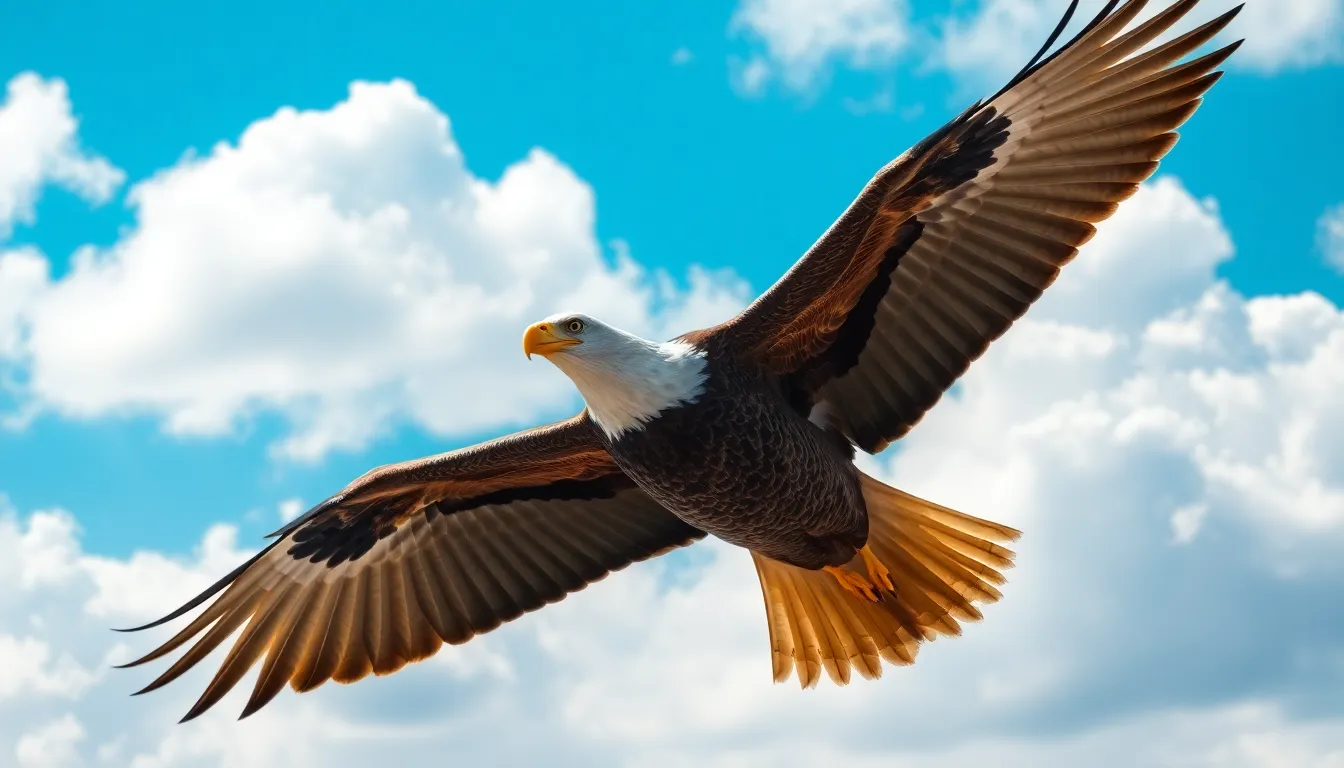
Eagle bird reproduction represents one of nature’s most sophisticated breeding systems, combining elaborate courtship displays with dedicated parental care that spans several months. These magnificent raptors demonstrate remarkable commitment to their offspring through complex mating rituals and intensive nurturing behaviors.
Mating Rituals
Eagle bird courtship displays involve spectacular aerial performances that demonstrate the strength and agility of potential mates. Pairs engage in synchronized flight patterns, including cartwheels, dives, and talon-locking displays that can reach speeds of 60 mph during courtship flights.
Bald eagles perform the famous “cartwheel” display where pairs lock talons and spin through the air for up to 200 feet before separating. Golden eagles execute high-speed dives and undulating flight patterns that showcase their hunting prowess to potential partners. These elaborate displays occur during breeding season, typically between February and April depending on geographic location.
Vocalizations play a crucial role in eagle bird mating rituals, with pairs producing distinctive calls that strengthen pair bonds. Established breeding pairs often return to the same territory year after year, with some partnerships lasting 20 years or more. Courtship feeding occurs when males present prey items to females, demonstrating their ability to provide for future offspring.
Nesting Habits
Eagle bird nests, called eyries, rank among the largest structures built by any bird species in North America. Bald eagles construct nests measuring 5 to 6 feet in diameter and 2 to 4 feet deep, with the largest recorded nest reaching 13 feet deep and 8 feet wide.
Construction materials include sticks, branches, moss, and soft materials like grass and feathers for the inner lining. Pairs typically build their nests 50 to 125 feet above ground in sturdy trees near water sources or on cliff ledges in mountainous regions. Golden eagles prefer cliff sites at elevations between 1,000 and 12,000 feet, while Harpy eagles select emergent trees in tropical rainforest canopies.
Nest renovation occurs annually, with established pairs adding new materials each breeding season. Some eyries have been used continuously for over 34 years, growing larger and more elaborate with each addition. Multiple nests within a territory provide backup options if the primary nest becomes damaged or disturbed.
Raising Young
Eagle bird reproduction cycles begin with females laying 1 to 3 eggs, with 2 eggs being most common across species. Incubation periods range from 35 days for smaller species to 45 days for larger eagles like the Harpy eagle, with both parents sharing incubation duties.
Newly hatched eaglets weigh approximately 3 ounces and depend entirely on parental care for survival. Parents provide constant protection and feeding, with adults hunting in shifts to ensure continuous food supply. Young eagles consume up to 1 pound of meat daily during peak growth periods between 6 to 10 weeks of age.
Fledging occurs at different ages depending on species, with Bald eagles leaving the nest at 10 to 14 weeks and Golden eagles fledging at 9 to 10 weeks. Post-fledging dependency continues for 4 to 11 weeks as parents teach hunting techniques and territorial boundaries. Juvenile eagles remain in their parents’ territory for several months, learning essential survival skills before establishing their own hunting ranges.
Sexual maturity in eagle bird species occurs between 4 to 6 years of age, when juveniles develop full adult plumage and begin seeking mates. Breeding success rates average 1.5 young per pair annually in healthy populations, with experienced pairs showing higher success rates than first-time breeders.
Cultural Significance of Eagle Birds
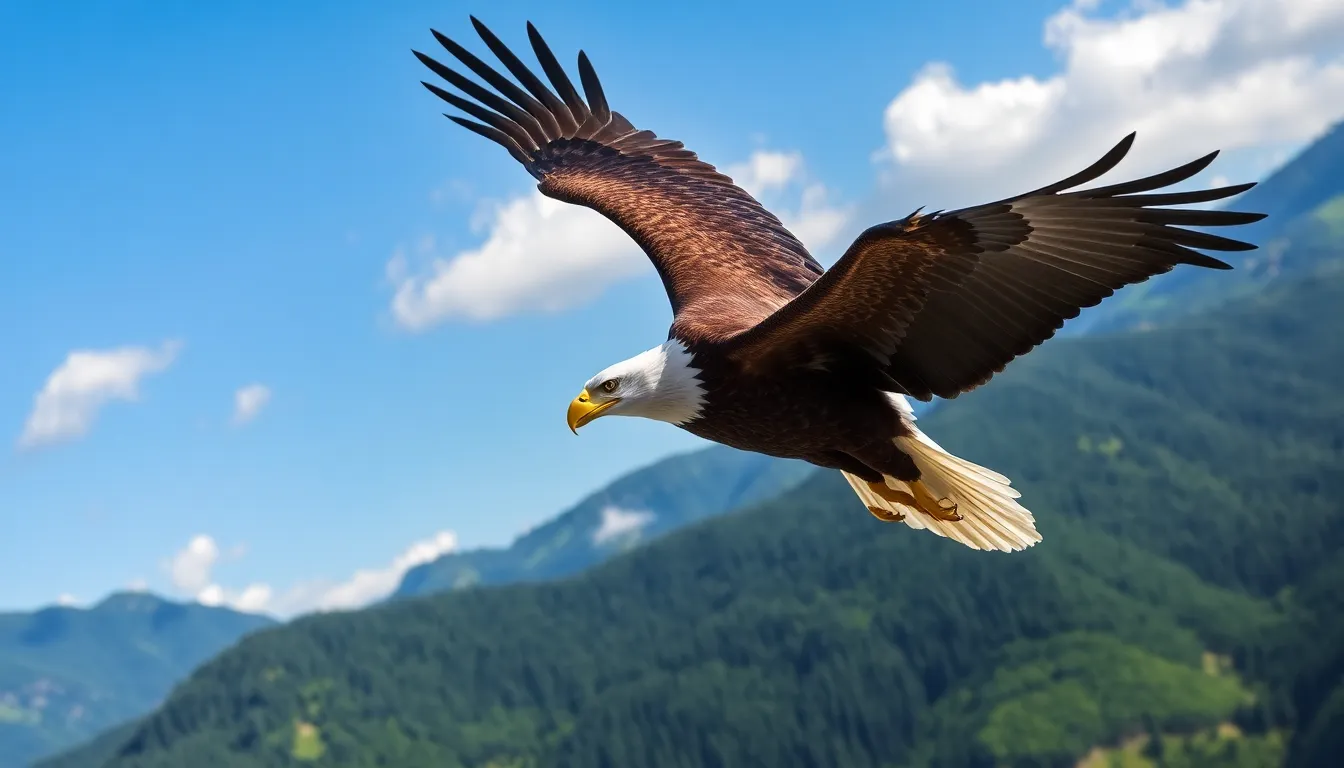
Eagle birds transcend their biological identity to become powerful symbols across human civilizations spanning thousands of years. Ancient civilizations recognized their dominance in the skies and adopted eagle imagery to represent divine power and earthly authority.
Eagles in Ancient Civilizations
Roman legions carried golden eagle standards into battle, with each legion’s aquila serving as a sacred emblem that soldiers protected with their lives. Zeus, the king of Greek gods, transformed into an eagle to demonstrate his supreme authority over mortals and deities alike. Egyptian pharaohs incorporated eagle motifs into royal regalia, believing these magnificent birds connected earthly rulers with celestial powers.
Mesopotamian cultures depicted eagles on cylinder seals and palace walls, associating them with storm gods and military victories. Native American tribes developed intricate spiritual relationships with eagle birds, considering their feathers sacred items that connected warriors and shamans to the spirit industry.
Modern National Symbols
Contemporary nations embrace eagle birds as primary emblems on official seals and currency. The United States features the Bald Eagle on its Great Seal, presidential flag, and dollar bills, representing freedom and strength since 1782. Germany displays the Bundesadler (Federal Eagle) on government buildings and official documents, continuing a tradition dating back to Charlemagne’s empire.
Mexico incorporates the Golden Eagle into its coat of arms, depicting the legendary bird perched on a cactus while grasping a serpent. Albania earned the nickname “Land of Eagles” and features a double-headed eagle on its national flag, symbolizing the country’s mountainous terrain and fierce independence.
| Country | Eagle Species | Symbolic Meaning | Year Adopted |
|---|---|---|---|
| United States | Bald Eagle | Freedom, strength | 1782 |
| Germany | Bundesadler | Unity, sovereignty | 800 AD |
| Mexico | Golden Eagle | Divine guidance | 1821 |
| Albania | Double-headed Eagle | Independence | 1912 |
Religious and Spiritual Symbolism
Christianity associates eagle birds with divine inspiration and resurrection, often depicting them alongside Saint John the Evangelist in medieval art. Islamic traditions reference eagles as symbols of courage and spiritual elevation, appearing in decorative patterns throughout mosque architecture.
Buddhism incorporates eagle imagery into teachings about mental clarity and transcendence of earthly limitations. Hindu scriptures describe Garuda, a mythical eagle-like creature that serves as the mount of Lord Vishnu, representing speed and martial prowess.
Eagles in Literature and Arts
Literary works throughout history employ eagle birds as metaphors for nobility, vision, and untamed spirit. Shakespeare referenced eagles in multiple plays, using their keen sight as symbols of perception and their soaring flight to represent ambition and freedom.
Contemporary artists continue depicting eagle birds in sculptures, paintings, and digital media, maintaining their status as icons of natural power and grace. Film industries worldwide feature eagle birds in documentaries and fictional narratives, reinforcing their cultural impact across global audiences.
Conservation Status and Threats
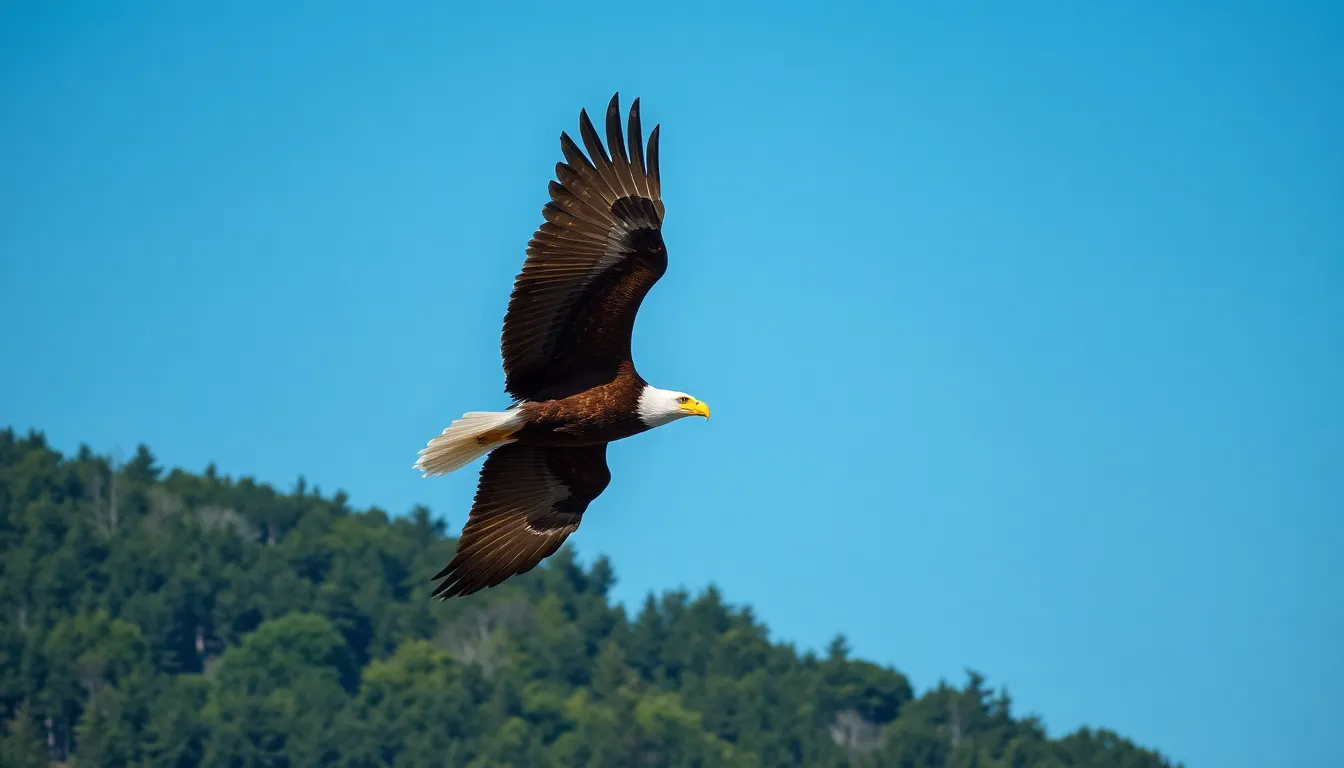
Eagle populations face unprecedented challenges across global ecosystems even though their symbolic significance and cultural importance. Current conservation status varies dramatically among the 60+ eagle species worldwide, with several species experiencing critical population declines while others demonstrate remarkable recovery success stories.
Population Recovery Success Stories
Bald Eagle conservation represents one of wildlife management’s greatest achievements in the 20th century. Population numbers plummeted to 417 breeding pairs in 1963 due to DDT pesticide use and habitat destruction. Conservation efforts including DDT bans, habitat protection, and captive breeding programs restored populations to over 71,400 breeding pairs by 2019. Spanish Imperial Eagles increased from 30 pairs in the 1970s to over 500 pairs today through targeted conservation measures.
Critical Threats Facing Eagle Populations
Habitat destruction poses the most important threat to eagle species globally, with deforestation eliminating nesting sites and hunting territories. Agricultural expansion destroys 10 million hectares of eagle habitat annually across key ranges. Wind turbines kill approximately 328,000 birds of prey each year in North America, with eagles representing 15% of these fatalities. Power line electrocution accounts for 1.8 million bird deaths annually, disproportionately affecting large raptors like eagles.
Species-Exact Conservation Challenges
| Eagle Species | IUCN Status | Primary Threats | Population Trend |
|---|---|---|---|
| Philippine Eagle | Critically Endangered | Deforestation, hunting | 800 individuals remaining |
| Steller’s Sea Eagle | Vulnerable | Lead poisoning, habitat loss | 5,000 individuals |
| White-bellied Sea Eagle | Near Threatened | Coastal development | Declining |
| Harpy Eagle | Near Threatened | Rainforest destruction | Stable in protected areas |
Environmental Contamination Impact
Lead poisoning affects 25% of tested Golden Eagle populations across western North America. Contaminated ammunition in hunter-killed game provides the primary exposure source, with blood lead levels exceeding toxic thresholds in affected birds. Pesticide residues continue impacting eagle reproduction rates 50+ years after DDT restrictions, with newer compounds like neonicotinoids reducing prey availability by 40%.
Climate Change Consequences
Rising temperatures shift prey distributions and alter migration patterns for eagle species across hemispheres. Arctic-breeding eagles face habitat loss as permafrost melts and vegetation zones migrate northward. Sea level rise threatens coastal nesting sites used by fish eagles, with projected losses of 30% of suitable habitat by 2050. Temperature increases reduce fish populations in mountain lakes by 15% annually, affecting Golden Eagle food sources.
Human-Wildlife Conflict Challenges
Livestock predation creates conflicts between ranchers and eagle populations, even though eagles taking less than 0.1% of livestock annually. Illegal shooting accounts for 30% of documented eagle mortalities in agricultural regions. Nest disturbance from recreational activities forces abandonment in 20% of monitored territories near popular outdoor areas.
Conservation Strategies and Protection Measures
Protected area establishment covers 35% of critical eagle habitats worldwide through national parks and wildlife refuges. Captive breeding programs maintain genetic diversity for endangered species like Philippine Eagles, with 41 individuals currently in breeding facilities. International cooperation through treaties like CITES regulates eagle trade and habitat protection across national boundaries. Education programs reduce human-eagle conflicts by 60% in participating communities through awareness campaigns and alternative livestock protection methods.
Monitoring and Research Initiatives
Satellite tracking reveals migration corridors spanning 1,500+ miles for various eagle species, informing habitat protection priorities. Genetic studies identify distinct populations requiring separate conservation approaches, with DNA analysis revealing previously unknown subspecies. Camera trap monitoring provides non-invasive population assessment methods with 85% accuracy rates compared to traditional counting techniques.
Conclusion
Eagles continue to captivate us with their unmatched combination of power grace and intelligence. These apex predators represent nature’s finest engineering showcasing adaptations that’ve been refined over millions of years.
Whether soaring through mountain valleys or diving into coastal waters eagles remind us of the wild’s untamed beauty. Their recovery stories like that of the Bald Eagle prove that dedicated conservation efforts can bring species back from the brink of extinction.
As we share this planet with these magnificent birds we’re responsible for protecting their habitats and ensuring future generations can witness their majesty. Eagles aren’t just birds – they’re living symbols of freedom strength and the enduring power of nature itself.
Frequently Asked Questions
How sharp is an eagle’s eyesight compared to humans?
Eagles have extraordinary vision that is 4 to 8 times sharper than human eyesight. Their eyes contain specialized cells that allow them to detect movements from great distances, making them one of the most visually acute animals on Earth. They can spot prey from over 2 miles away, which is crucial for their hunting success.
What is the grip strength of an eagle’s talons?
Eagle talons are incredibly powerful, capable of generating a grip force of 750 pounds per square inch (psi). This immense strength allows them to secure and carry prey effectively. Their sharp, curved talons are perfectly designed for grasping and holding onto various types of prey during flight.
How fast can eagles dive when hunting?
Eagles can reach impressive diving speeds of up to 200 mph during hunting attacks. Golden Eagles specifically can exceed 150 mph during their diving pursuits. These high-speed dives, combined with their exceptional eyesight and powerful talons, make them incredibly effective predators in the animal kingdom.
What is the wingspan of an eagle?
Eagles typically have wingspans ranging from 6 to 8 feet, depending on the species. Their body lengths range from 24 to 40 inches. This impressive wingspan allows them to soar efficiently over long distances while hunting and provides the lift necessary for carrying prey back to their nests.
How successful has Bald Eagle conservation been?
Bald Eagle conservation has been remarkably successful. The population recovered from just 417 breeding pairs in 1963 to over 71,400 pairs by 2019. This dramatic recovery was achieved through dedicated conservation efforts, including habitat protection, banning harmful pesticides like DDT, and implementing breeding programs.
Where do eagles build their nests?
Eagles build their nests, called eyries, in high locations such as tall trees, cliffs, or man-made structures. These nests are among the largest built by any bird species and are often renovated annually. Established pairs typically return to the same territory and may use the same nest for many years.
What do different eagle species primarily eat?
Eagle diets vary by species and habitat. Bald Eagles primarily consume fish, while Golden Eagles target medium-sized mammals like rabbits and ground squirrels. Harpy Eagles specialize in hunting arboreal mammals such as sloths and monkeys in tropical rainforests, showcasing their adaptation to specific environments.
How long do eagle chicks stay in the nest?
Eagle chicks, called eaglets, typically remain in the nest for 10-14 weeks depending on the species. During this time, both parents provide dedicated care, bringing food and protecting the young. After fledging, parents may continue to support their offspring for several additional weeks as they learn to hunt independently.
What threats do eagles face in the wild?
Eagles face several significant threats including habitat destruction, agricultural expansion, human-wildlife conflicts, and climate change. Some species like the Philippine Eagle are critically endangered, while others have recovered through conservation efforts. Pollution, power line collisions, and illegal hunting also pose ongoing challenges to eagle populations worldwide.
Why are eagles considered cultural symbols?
Eagles have been revered across civilizations as symbols of power, freedom, and divine connection. Ancient cultures like Rome, Greece, and Egypt incorporated eagle imagery into their regalia and mythology. Today, eagles appear on national emblems and currency, with the Bald Eagle representing American freedom and various species symbolizing strength in cultures worldwide.












